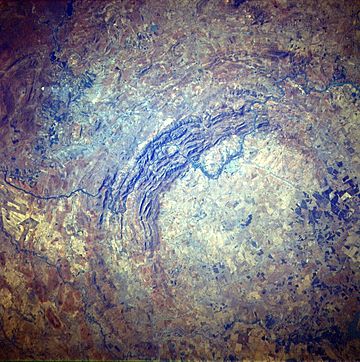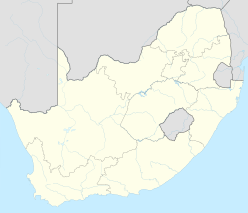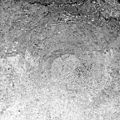Vredefort crater facts for kids
| Vredefort Dome (centre) | |

Vredefort Dome, seen from space by STS-51-I
|
|
| Impact crater/structure | |
|---|---|
| Confidence | Confirmed |
| Diameter | 300 km (190 mi) |
| Age | 2,023 ± 4 Ma Paleoproterozoic |
| Exposed | Yes |
| Drilled | Yes |
| Location | |
| Coordinates | 27°0′0″S 27°30′0″E / 27.00000°S 27.50000°E |
| Country | South Africa |
| Province | Free State |
| UNESCO World Heritage Site | |
| Official name | Vredefort Dome |
| Includes |
|
| Criteria | Natural: (viii) |
| Inscription | 2005 (29th Session) |
| Area | 30,000 ha (120 sq mi) |
Vredefort crater is the largest verified impact crater on Earth. That means we know for certain it was caused by an asteroid or meteorite strike. The crater is in the Free State Province of South Africa.
In 2005, the Vredefort Dome was added to the list of UNESCO World Heritage Sites as a natural site of geologic interest.
Formation and structure
The asteroid that hit Vredefort was one of the largest ever to strike Earth since the Hadean eon, some four billion years ago. It is thought to have been about 5–10 km (3–6 miles) in diameter.
The crater has a diameter of roughly 250–300 km (160–190 mi), larger than the 200 km (120 mi) Sudbury Basin and the 170 km (110 mi) Chicxulub crater. This makes Vredefort the largest known impact structure on Earth. If the Wilkes Land crater in Antarctica is an impact crater then it is the largest known at 500 km (310 mi) diameter.
The Vredefort crater's age is estimated to be 2.023 billion years (± 4 million years) which places it in the Palaeoproterozoic era. It is the second-oldest known crater on Earth, a little less than 300 million years younger than the Suavjärvi crater in Russia. In comparison, it is about 10% older than the Sudbury Basin impact (at 1.849 billion years).
It was originally thought that the crater was formed by a volcanic explosion, but in the mid 1990s evidence showed that it was the site of a huge bolide impact. Telltale shatter cones were discovered in the bed of the nearby Vaal River.
The Vredefort crater site is one of the few multi-ringed impact craters on Earth, although they are more common elsewhere in the Solar System. Perhaps the best-known example is Valhalla crater on Jupiter's moon Callisto, although Earth's Moon has a number as well. Geological processes, such as erosion and plate tectonics, have destroyed most multi-ring craters on Earth.
The nearby Bushveld Igneous Complex (BIC) and Witwatersrand Basin were created during this same period, leading to speculation that the bolide was big and fast enough to cause local volcanism. The BIC is where most of the world's known reserves of platinum group metals (PGMs) are found, while the Witwatersrand basin holds most of the known reserves of gold.
The Vredefort dome in the center of the crater is home to three towns: Parys, Vredefort and Koppies.
Images for kids
-
A schematic diagram of a NE (left) to SW (right) cross-section through the 2.020-billion-year-old Vredefort impact crater and how it distorted the contemporary geological structures. The present erosion level is shown. Johannesburg is where the Witwatersrand Basin (the yellow layer) is exposed at the "present surface" line, just inside the crater rim, on the left. Not to scale.
See also
 In Spanish: Cráter de Vredefort para niños
In Spanish: Cráter de Vredefort para niños



